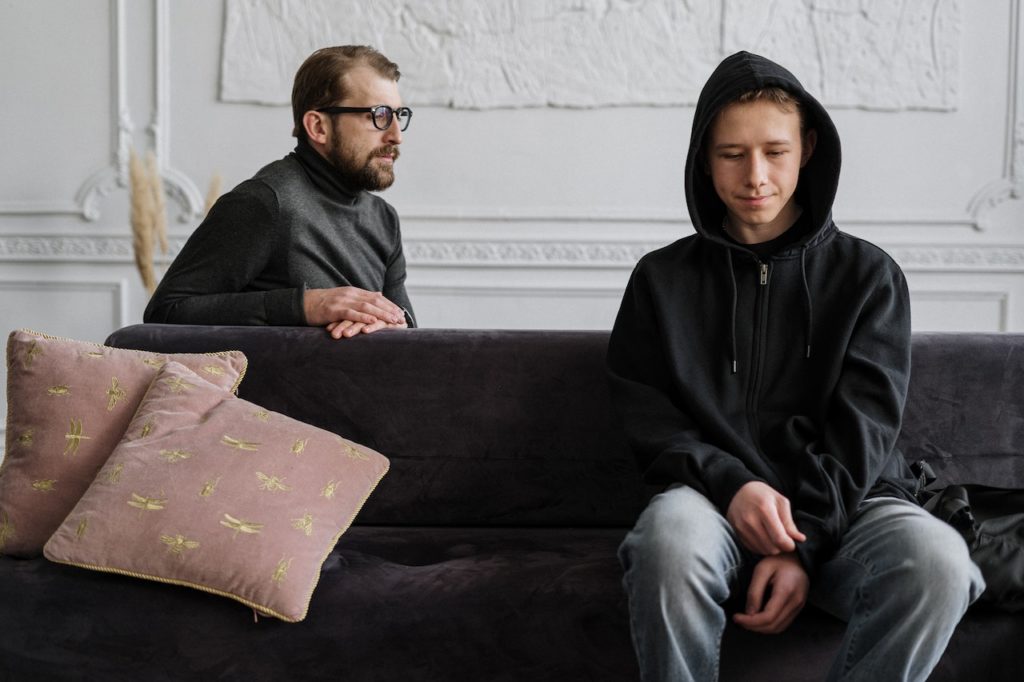Certainly, anxiety’s influence on your child’s daily life could be a source of worry. Cognitive-Behavioral Therapy (CBT) potentially offers a resolution. Recognized as one of the top psychotherapeutic treatments, CBT aids children and adolescents in handling their anxious emotions and thoughts constructively. Amy MacIntyre MD, discusses why CBT is successful at helping kids with anxiety thrive and provides advice on what to expect when accessing therapy services for your child.
Defining Cognitive-Behavioral Therapy (CBT) and its Benefits

You might have heard of cognitive-behavioral therapy (CBT) as a talk therapy that can help individuals tackle their mental health challenges. CBT is a psychotherapy focusing on changing negative thought patterns, behaviors, and emotions to improve one’s mental well-being. The therapy is grounded in the idea that our thoughts and behaviors shape how we feel and that we can improve our mental health by changing them. CBT treats anxiety, depression, post-traumatic stress disorder, and other mental health conditions. Its benefits include reduced symptoms, improved coping mechanisms, enhanced problem-solving skills, and better overall quality of life. CBT can also be delivered in various formats, such as individual or group therapy, self-help materials, and digital interventions.
Understanding Anxiety in Kids Through CBT
Anxiety is a common occurrence in kids. Understanding it is important for parents and caregivers. Cognitive Behavioral Therapy, or CBT, is a useful tool to help kids learn how to manage their anxiety. It works by identifying negative thoughts or patterns that lead to anxious behavior. Using techniques such as relaxation and cognitive restructuring, kids are taught to recognize and change negative thoughts into positive ones. This method allows kids to take control of their emotions and build confidence in themselves. CBT can help kids develop the skills to cope with anxiety and lead happy, healthy lives.

Exploring Different Techniques Used in CBT
Cognitive-behavioral therapy is a widely used focus on changing negative thought patterns and behaviors. One of the many benefits of CBT is its versatility – it can be tailored to each individual’s unique needs and circumstances. Several techniques are used in CBT, ranging from cognitive restructuring to exposure therapy. In cognitive restructuring, therapists work with patients to identify and challenge negative thought patterns. In exposure therapy, patients should deal with anxiety in a safe and controlled environment. Regardless of the technique used, CBT aims to empower patients to take control of their thoughts and behaviors.
Realizing the Impact of CBT on Kids with Anxiety
Anxiety can be challenging for kids, and cognitive-behavioral therapy (CBT) has been demonstrated to be a viable treatment option. This therapeutic approach challenges kids to reframe negative thoughts and replace them with positive ones. As young patients develop a different, more helpful perspective on their anxiety symptoms, they feel more confident and in control. The power of CBT lies in its ability to set the foundation for lifelong coping mechanisms that can be used to mitigate symptoms of anxiety in adulthood. By recognizing the impact of CBT on kids with anxiety, parents, educators, and medical professionals will be able to offer meaningful support and care to those in need.
Teaching Healthy Coping Strategies through CBT
Teaching healthy coping strategies is essential for individuals to manage their everyday challenges and reduce distress in the long term. Cognitive Behavioral Therapy (CBT) can optimize coping strategies and improve emotional well-being. Working with a qualified CBT therapist, individuals can identify patterns and beliefs that influence their behavior, recognizing their automatic responses to stressors. Through CBT, individuals can learn coping strategies, such as positive self-talk, mindfulness, and problem-solving, that are personalized to their unique needs. By integrating healthy coping mechanisms to manage life stressors, individuals can improve their mental health and well-being in the long term. CBT provides individuals a safe and effective tool to manage their challenges and live with greater resilience and emotional balance.

Establishing a Support System for Children With Anxiety
Anxiety is a common mental health condition affecting children and young adults. Establishing a support system can make a big difference in how they manage their symptoms. Building a support network can give children the resources they need to feel heard, understood, and safe. This support can offer children comfort and confidence in addressing their anxiety issues and help them become happy people. By recognizing the importance of a support system early on, parents and caregivers can give their children the tools they need to thrive despite anxiety.
Examples of Successful Cases of CBT Helping Kids With Anxiety Thrive
In recent years, Cognitive Behavioral Therapy (CBT) has emerged as a treatment for anxiety disorders in children. One of the key benefits of CBT is that it encourages children to develop coping mechanisms to deal with their anxiety rather than avoiding the things that trigger it. This approach has worked wonders for many kids, significantly improving their emotional well-being. Examples of this success can be seen in the case of a 10-year-old girl who had severe social anxiety and could not attend school. After undergoing CBT, she returned to school, joined the drama club, and began speaking up in class. Another example is a 12-year-old boy who had panic attacks every time he had to speak in public. He learned how to manage his anxiety with CBT and won a public speaking competition. These success stories demonstrate the power of CBT in helping children overcome their anxiety and thrive.
Final Thoughts
With the right application of techniques, Cognitive-Behavioral Therapy can improve the lives of children with anxiety and help them live full and healthy lives. To ensure this, strategies must be applied to address their root fears and worries. It is also important to create an environment around these children so that all stakeholders can provide consistent reinforcement as they learn to cope with and overcome their fears. Moreover, mental health experts should seek out successful cases of CBT helping kids with anxiety, learn from those examples, and implement those lessons for future cases. Ultimately, it is through education and compassion that these kids are given hope to thrive. Everyone has a part to play – parents and teachers need to properly support children with anxiety by equipping them with the right knowledge necessary; mentors should act as a soundboard if needed; and mental health professionals should continue using CBT to lead kids on the path to reclaiming their lives from anxiety.